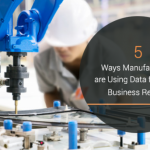Data is the Answer for Transportation and Logistics Companies. But What is the Question?

Technology is rapidly disrupting the transportation and logistics (T&L) industry. New technology investments are shifting companies from being paper-based and analog to digital and data-driven in their decision making. At the same time, transactions with IoT enabled consignments create an avalanche of data. How can this data be harnessed to gain real-time visibility across the entire supply chain, leading to new business opportunities and better results?
Unfortunately, many T&L companies are still struggling in terms of using this data effectively. PWC showed that only 28 percent of T&L companies rate themselves as “advanced” when it comes to digitization. As a result, 68 percent say they cannot provide key decision makers access to information required for business decisions. This lack of a cohesive data strategy puts T&L companies at risk of making critical mistakes that cost them in time, money, and wasted effort.
This article will show how technology is driving the shift toward big data and explain how T&L companies can position themselves to use this data effectively.
Technology is Driving the Data Revolution
Across the manufacturing sector companies are investing heavily in new technologies, and this shift toward digitization is happening at T&L companies as well. One of the biggest innovations is the Industrial Internet of Things, or IIoT.
Essentially a network of intelligent computers, sensors, devices, and objects, IIoT means companies have access to huge amounts of data on everything from the location of vehicles to how products are stored to whether equipment needs maintenance. It’s these exciting possibilities that have led the T&L industry to spend $78 billion on IIoT in 2017.
Other technologies that are having an impact are location tracking solutions, blockchain, automation, and mobile devices. Machine learning and artificial intelligence will also be critical to help companies analyze vast amounts of data, while cloud-based storage platforms are needed to store the data and make it available to users anytime, anywhere, and on any device.
Collecting Data Isn’t the Challenge – Using It Is
Used correctly, big data will allow T&L companies to predict demand more accurately, optimize delivery routes, conduct pre-emptive maintenance on equipment and vehicles, increase worker safety, and know the location of every vehicle and every product in real-time. It has the power to revolutionize the way goods are delivered and create new business models and revenue opportunities that haven’t been available before.
But all of this is only possible if you know what you’re looking for. The data that’s relevant to you will look different depending on what you’re trying to do. In general, patterns can be identified and predictive models can support business leaders to plan and allocate resources to the spikes and troughs of business. Specifically, T&L companies can use data to answer questions such as:
- How can we reduce wear and tear on our fleet while mitigating maintenance costs?
- Why are deliveries behind schedule?
- Why are products being damaged on the route, and is there something we can do to avoid this?
- How many staff are required at different times of the year?
- What are our opportunities for future growth and new revenue streams?
With so much data coming in from IIoT devices and other sources, collecting the data won’t be the problem. Instead, companies will need to put new systems, organizational structures, and people in place to identify the relevant insights and apply them when making strategic decisions.
Sorting and analyzing vast amounts of data will require advanced analytics software and machine learning capabilities. For example, it needs to be easy for a user to call up the data they need, visualize it, and clearly understand what they are looking at.
Beyond this, organizational structures need to be adapted to support the free flow of information across departments. True supply chain visibility can only be realized as silos are torn down and people have access to the data they need. A recent survey showed that 67 percent of manufacturing companies are struggling to share key information between departments. This will have to change as data becomes more important.
Finally, big data still requires people who have a deep understanding of the business. It’s important to remember that you can’t simply pull a report and suddenly get the insight you need. You need to know what outcomes you expect when making a strategic decision, understand the challenges your business is facing, and have a clear view of what the organization will look like in the next 5-10 years. Through this, you’ll be able to ask the right questions and extract the most relevant information.
Data is Powerful, But Only If You Know How to Use It
The transportation and logistics sector is rapidly embracing technology and digitization. As a result, companies will have access to more data than ever before. This data can be used to increase revenue, reduce costs, improve delivery times, optimize equipment usage, and ultimately make companies more profitable. The insights gained from big data can help position T&L companies for success, not just today, but for the future as well.
However, simply having access to data isn’t enough. The outcomes that are most important to your business will determine how you collect, analyze, and use data, and it will shape how you incorporate it into your strategic decision making. Because at the end of the day, data may hold the answer, but only if you are asking the right questions.
To see how digital transformation can be applied solve specific T&L business problems, read our logistics & warehousing business use cases here.
Remember, digital transformation is about more than new technology – it is about seeing new ways to do business. Contact Optimized Solutions to define your business model, understand how you are making money today, and anticipate how your business would be different in the digital economy of tomorrow.




